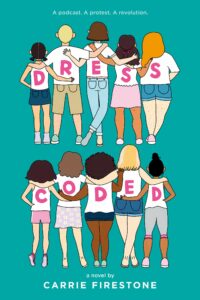Dear TBR…
The first day of seventh grade, I wore a giant, oversized top, and no one saw anything but the top of my head, because the whole day I pretty much studied my shoes.
Throughout middle and high school, I wore huge tops regularly – because by 7th grade I was already in a C-cup, unlike everyone else but teachers in the entire junior high. Throughout middle and high school, my homeroom teacher pulled my giant, oversized top sharply toward my neck just about every time she saw me, because I needed to “cover up those bra straps.”
The last time I saw my homeroom teacher – in the year of our Lord 2018, as a grown adult, she reached out and started buttoning up my shirt as I said hello to her. I tried to laugh it off, but y’know what? That’s. Not. Funny.
Dress codes can make some people lose all perspective.

The middle grade experience is pretty universal for middle-elementary school ages the world over, and though I attended a private, Christian middle school, the incidents and comments in this book are really, really familiar to me — and brought up some things I’d kicked far into the back corner of my metaphoric mental closet. (Ugh.)
For that, and other reasons, this was somewhat of a tough read. Smoothly and quietly written, with chapters of live action interspersed with protagonist Molly Frost’s podcast, Dress Coded, the novel dumps readers head-first into middle school culture, complete with active shooter drills, that one boy who always makes up mean names for people, unrequited crushes, paralyzing embarrassment, and parent drama. DRESS CODED released last summer, and even before it hit shelves, people reminisced about their middle school experiences – wearing uniforms or not, trying to hide or reveal a newly adult-ish body as they battled growth spurts, being the “shrimp,” acne, periods that arrived on time or seemed to have been lost in the mail. DRESS CODED brings back a lot of things we’re happier forgetting about middle school – the shaming and the mockery. The discomfort and unsureness. The fear of public opinion. On top of all of the adolescent angst, having adults pick at you for an inch of skin showing on your abdomen or lower back because your shirt rides up, or your bra straps show, or your skirt is too short or your sweater is too big… after a while, it takes a toll.
Protagonist Molly Frost’s entire middle school experience has been mostly about dealing with dress-codes, the disparity in the manner in which they’re applied, and the realization that they don’t even know the name of the woman who was hired by the principal to make sure that the girls toe the line — the GIRLS, mind you. The boys are, throughout the book, never found in violation of any dress code. The principal has the page laminated from the student handbook, and began to enforce it – complete with detention, the first day of 7th grade. He carries the sheet with him, and spends far too much time scrutinizing female bodies, looking for ways in which it does not conform to his satisfaction. By eighth grade it had made school untenable for Molly and her friends, and they finally said, “ENOUGH.”
Now, DRESS CODED is not a totally triumphant story, in which everyone suddenly “sees sense” and comes to the rescue; Molly isn’t perfect and floating above it all with a clear sense of her rights and privileges. She’s young, flawed, scarred by and scared of the experiences she sees other having. While she’s wildly empathetic and cares so much, she sometimes entertains magical thinking – “If I could just do X, then Y would surely happen! – and that leads to a few mistakes. Despite her brilliant podcast idea, some of her students reject the idea that it’s “a big deal,” and some of the adults from the community, with no kids at the school show up to make sure she knows they think she’s spoilt and rude. Even some of the teachers she likes remain convinced that this is just youthful whatever that will pass. The dress code issue doesn’t begin to be rectified until the last two days of middle school — and it still would’ve been ignored of swept under the rug if it weren’t for a timely sit-in that involved both the high school, and members of the press.
DRESS CODED underscores the ridiculousness of a society which on one hand idolizes youth culture, and a retail culture which works hard to manufacture and advertise to that segment of society while at the same time denigrating, mocking, and diminishing it. It shows our fractured psychology with reference to girls, and explains why we are a sexist, misogynistic mess in our country. I appreciate that while there is a hopeful conclusion, the flawed people aren’t immediately cleaned up and presented as better and wiser. They have work to do – they were awful, and they have mistakes for which to atone. This book holds up a sad mirror which shows girls in our culture only seen in terms of their collective body parts instead of their personhood, their potential for damage (Distracting. Revealing. Unladylike) instead of their educational needs and goals. I know that my junior high dress code seemed like it was cemented in the ceaseless ages of time, and it wouldn’t have occurred to us that we could EVER make change, but I’m hopeful that other girls can take this model and at least begin some much needed conversation, especially in private religious school settings. And I REALLY hope someday girls can live in a world where no one ever again has to kneel down to show a teacher that her skirt touches the floor and that her fingertips aren’t longer than her hemline. Good grief.
Until the next book,
A Constant Reader